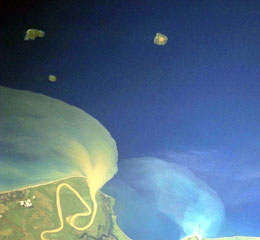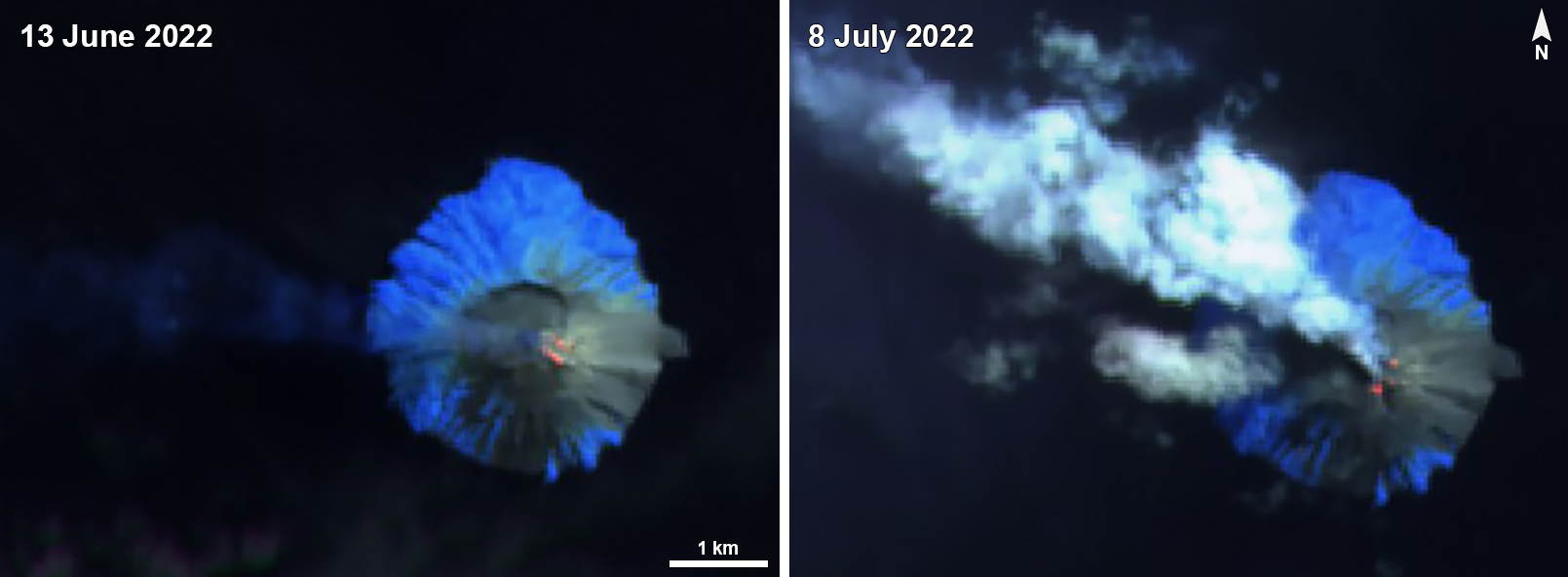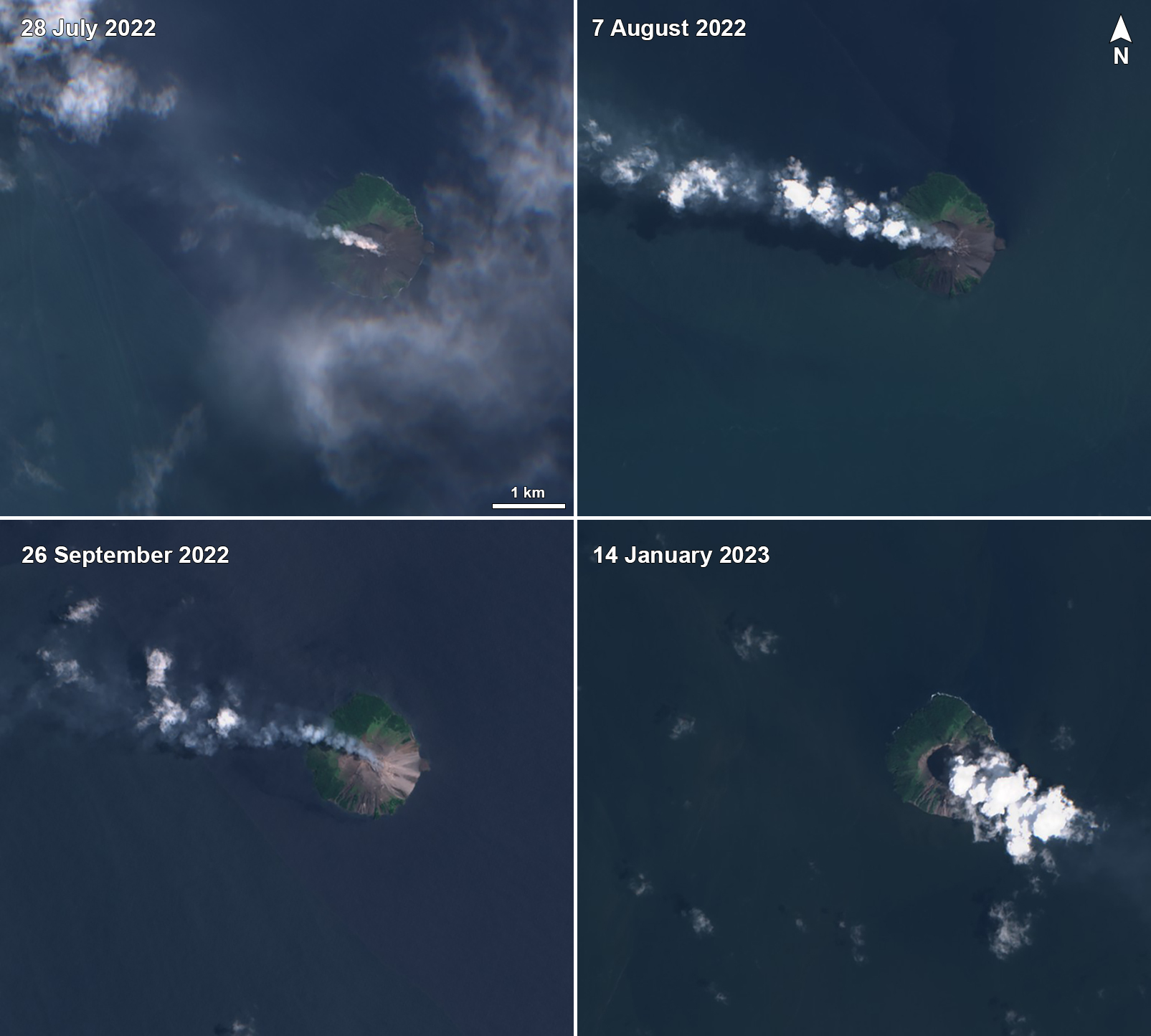Report on Kadovar (Papua New Guinea) — February 2023
Bulletin of the Global Volcanism Network, vol. 48, no. 2 (February 2023)
Managing Editor: Benjamin Andrews.
Edited by Kadie L. Bennis.
Kadovar (Papua New Guinea) Ash plumes, two weak thermal anomalies, and gas-and-steam plumes during June 2022-January 2023
Please cite this report as:
Global Volcanism Program, 2023. Report on Kadovar (Papua New Guinea) (Bennis, K.L., and Andrews, B., eds.). Bulletin of the Global Volcanism Network, 48:2. Smithsonian Institution.
Kadovar
Papua New Guinea
3.608°S, 144.588°E; summit elev. 365 m
All times are local (unless otherwise noted)
Kadovar is a 2-km-wide island located in the Bismarck Sea off the coast of New Guinea about 25 km NNE from the mouth of the Sepik River. A period of heightened thermal activity took place in 1976. Prior to 2018, a lava dome formed the high point of the volcano. An eruption began in January 2018 that included lava effusion from vents at the summit and at the E coast. More recent activity has consisted of occasional ash plumes and weak thermal anomalies (BGVN 47:06). Similar activity persisted during this reporting period of June 2022 through January 2023 using information from the Darwin Volcanic Ash Advisory Center (VAAC) and satellite data.
Activity during the reporting period consisted of occasional ash plumes that were reported by satellite observations and wind model data from the Darwin VAAC. Ash plumes rose to 2.1 km altitude on 14 August and 1.2 km altitude on 31 August, both of which drifted NW. During 18-19 September ash plumes rose to 1.5 km altitude and drifted NW and WNW. On 11 December an ash plume rose to 1.5 km altitude and drifted S. On clear weather days, Sentinel-2 infrared satellite imagery showed very small thermal anomalies at the summit crater on 13 June and 8 July 2022 (figure 65). In addition, occasional white gas-and-steam plumes were sometimes visible in Sentinel-2 satellite imagery on clear weather days that drifted generally NW (figure 66). MODIS satellite instruments analyzed using the MODVOLC thermal algorithm detected a single thermal hotspot on the E side of the island on 28 November.
Geological Summary. The 2-km-wide island of Kadovar is the emergent summit of a Bismarck Sea stratovolcano of Holocene age. It is part of the Schouten Islands, and lies off the coast of New Guinea, about 25 km N of the mouth of the Sepik River. Prior to an eruption that began in 2018, a lava dome formed the high point of the andesitic volcano, filling an arcuate landslide scarp open to the south; submarine debris-avalanche deposits occur in that direction. Thick lava flows with columnar jointing forms low cliffs along the coast. The youthful island lacks fringing or offshore reefs. A period of heightened thermal phenomena took place in 1976. An eruption began in January 2018 that included lava effusion from vents at the summit and at the E coast.
Information Contacts: Darwin Volcanic Ash Advisory Centre (VAAC), Bureau of Meteorology, Northern Territory Regional Office, PO Box 40050, Casuarina, NT 0811, Australia (URL: http://www.bom.gov.au/info/vaac/); Hawai'i Institute of Geophysics and Planetology (HIGP) - MODVOLC Thermal Alerts System, School of Ocean and Earth Science and Technology (SOEST), Univ. of Hawai'i, 2525 Correa Road, Honolulu, HI 96822, USA (URL: http://modis.higp.hawaii.edu/); Sentinel Hub Playground (URL: https://www.sentinel-hub.com/explore/sentinel-playground).



